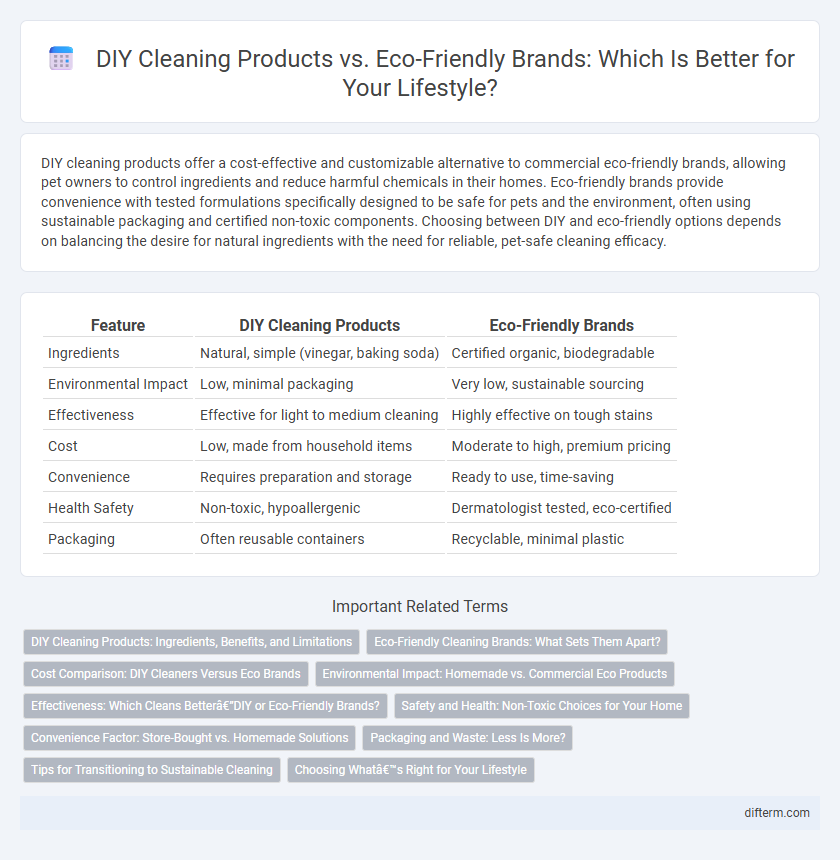DIY cleaning products offer a cost-effective and customizable alternative to commercial eco-friendly brands, allowing pet owners to control ingredients and reduce harmful chemicals in their homes. Eco-friendly brands provide convenience with tested formulations specifically designed to be safe for pets and the environment, often using sustainable packaging and certified non-toxic components. Choosing between DIY and eco-friendly options depends on balancing the desire for natural ingredients with the need for reliable, pet-safe cleaning efficacy.
Table of Comparison
| Feature | DIY Cleaning Products | Eco-Friendly Brands |
|---|---|---|
| Ingredients | Natural, simple (vinegar, baking soda) | Certified organic, biodegradable |
| Environmental Impact | Low, minimal packaging | Very low, sustainable sourcing |
| Effectiveness | Effective for light to medium cleaning | Highly effective on tough stains |
| Cost | Low, made from household items | Moderate to high, premium pricing |
| Convenience | Requires preparation and storage | Ready to use, time-saving |
| Health Safety | Non-toxic, hypoallergenic | Dermatologist tested, eco-certified |
| Packaging | Often reusable containers | Recyclable, minimal plastic |
DIY Cleaning Products: Ingredients, Benefits, and Limitations
DIY cleaning products commonly use natural ingredients such as vinegar, baking soda, lemon juice, and essential oils, which are effective for disinfecting and deodorizing while reducing exposure to harsh chemicals. These homemade solutions offer cost savings, environmental benefits by minimizing plastic waste, and customization options to suit specific cleaning needs. However, limitations include inconsistent potency, potential surface damage with improper use, and a lack of certification compared to standardized eco-friendly brand products.
Eco-Friendly Cleaning Brands: What Sets Them Apart?
Eco-friendly cleaning brands distinguish themselves through the use of sustainable, non-toxic ingredients that minimize environmental impact and reduce exposure to harmful chemicals in homes. These brands often prioritize biodegradable packaging and renewable resources, aligning with zero-waste and carbon-neutral commitments. Their transparent labeling and certifications, such as EPA Safer Choice or Green Seal, ensure safer indoor air quality and promote healthier lifestyle choices compared to conventional DIY cleaning products.
Cost Comparison: DIY Cleaners Versus Eco Brands
DIY cleaning products typically cost significantly less than eco-friendly brands, often requiring only basic household ingredients like vinegar, baking soda, and lemon juice. Eco-friendly brands, while more expensive, offer convenience, tested formulations, and certifications such as USDA Organic or EPA Safer Choice, which assure consumers of non-toxic and sustainable components. Considering long-term expenses, DIY solutions can reduce costs by up to 70%, but eco-brands may save money by minimizing health and environmental risks associated with harsher chemicals.
Environmental Impact: Homemade vs. Commercial Eco Products
Homemade DIY cleaning products often use natural ingredients like vinegar, baking soda, and essential oils, reducing reliance on synthetic chemicals that can harm aquatic ecosystems and soil health. Commercial eco-friendly brands typically undergo rigorous environmental testing and certification, ensuring biodegradability and minimal carbon footprints throughout production and packaging. Comparing environmental impact, DIY solutions lower transportation emissions by using locally sourced ingredients, while eco-friendly brands contribute to sustainability through innovation in recyclable materials and eco-conscious formulas.
Effectiveness: Which Cleans Better—DIY or Eco-Friendly Brands?
DIY cleaning products often utilize natural ingredients like vinegar, baking soda, and lemon, offering effective solutions for everyday grime and light stains, but may struggle against tough, greasy residues. Eco-friendly brands invest in advanced formulations and rigorous testing, typically providing superior cleaning power without harsh chemicals, making them more reliable for deep cleaning tasks. Consumer reviews and lab tests frequently highlight eco-friendly products as more consistent in performance, balancing environmental benefits with cleaning effectiveness.
Safety and Health: Non-Toxic Choices for Your Home
DIY cleaning products often use natural ingredients like vinegar, baking soda, and essential oils, reducing exposure to harmful chemicals and promoting a safer home environment. Eco-friendly brands prioritize biodegradable and non-toxic formulas certified by organizations such as EcoLogo and EPA Safer Choice, further ensuring health-conscious cleaning solutions. Choosing either option minimizes respiratory irritants and chemical residues, protecting family members, pets, and indoor air quality.
Convenience Factor: Store-Bought vs. Homemade Solutions
Store-bought eco-friendly cleaning brands offer unmatched convenience with ready-to-use formulas and consistent quality, saving time for busy households. Homemade DIY cleaning products require gathering ingredients like vinegar, baking soda, and essential oils, which can be cost-effective but demand preparation and measuring. Consumers often weigh immediate accessibility and performance of commercial products against the sustainability and customization potential of DIY solutions.
Packaging and Waste: Less Is More?
DIY cleaning products significantly reduce packaging waste by utilizing reusable containers and minimal plastic compared to eco-friendly brands, which often rely on biodegradable but single-use packaging. Eco-friendly brands emphasize sustainable materials like recycled paper and compostable plastics, yet their packaging still generates more waste than refillable DIY options. Choosing DIY solutions supports a zero-waste lifestyle by cutting down on overall packaging volume and promoting container reuse.
Tips for Transitioning to Sustainable Cleaning
Switching to sustainable cleaning involves gradually replacing chemical-laden DIY products with eco-friendly brands known for biodegradable ingredients and minimal packaging. Start by identifying household areas with the highest chemical use and substituting those with certified green alternatives to reduce indoor pollution and environmental impact. Maintaining a routine of testing new products on small surfaces ensures safety and effectiveness, promoting a healthier home and planet.
Choosing What’s Right for Your Lifestyle
Choosing between DIY cleaning products and eco-friendly brands depends on your lifestyle's priorities such as convenience, cost, and environmental impact. DIY cleaning solutions often use basic ingredients like vinegar and baking soda, offering customization and affordability, while eco-friendly brands provide ready-made, certified non-toxic products that save time. Evaluating your daily routine, sensitivity to chemicals, and commitment to sustainability helps determine the best option for maintaining a healthy home environment.
DIY cleaning products vs Eco-friendly brands Infographic

 difterm.com
difterm.com